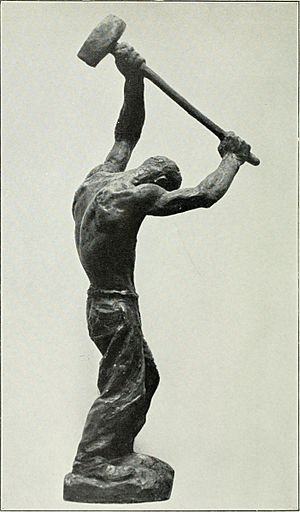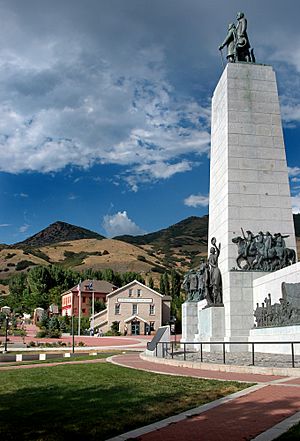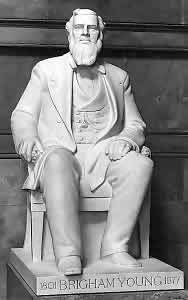Mahonri Young facts for kids
Quick facts for kids
Mahonri Young
|
|
|---|---|
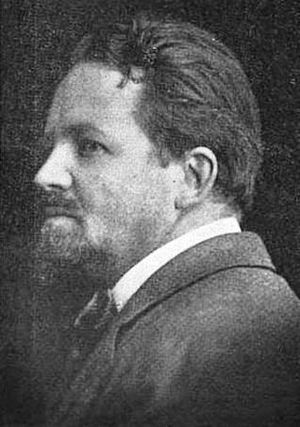 |
|
| Born |
Mahonri Mackintosh Young
August 9, 1877 |
| Died | November 2, 1957 (aged 80) |
| Resting place | Salt Lake City Cemetery, Utah |
| Nationality | American |
| Known for | Sculpting |
|
Notable work
|
Seagull Monument (1913) This is the Place Monument (1947) Brigham Young (1949) |
| Movement | Social realism |
| Spouse(s) | Cecelia Sharp Dorothy Weir |
| Medal record | ||
|---|---|---|
| Art competitions | ||
| Representing the |
||
| Olympic Games | ||
| Gold | 1932 Los Angeles | Sculpture: Statues |
Mahonri Mackintosh Young (born August 9, 1877 – died November 2, 1957) was an American sculptor and artist. He was known for his realistic style, often called social realism.
During his long career, he created many artworks. These included over 320 sculptures, 590 oil paintings, and thousands of drawings. He is best known for his sculptures. His art showed landscapes, people's faces, and large monuments.
Mahonri Young liked to work quickly. He often made fast sketches on the spot instead of using models in a studio. He felt this made his art look more natural. He became successful in his mid-30s. Large projects for the Church of Jesus Christ of Latter-day Saints (LDS Church) helped him a lot.
Young was the grandson of Brigham Young, a famous leader and the first Governor of Utah. Mahonri grew up in Salt Lake City, Utah. He moved to New York City and became part of a group of artists called "The Eight" and the Ashcan School.
Some of his most famous works are in Salt Lake City. These include the This Is The Place Monument and the Seagull Monument. A statue of Brigham Young by Mahonri is in the United States Capitol Building in Washington, D.C. He also taught art at the Art Students League. Most of his artwork is now kept at Brigham Young University.
Contents
Early Life and Art Beginnings
Mahonri Mackintosh Young was born in Salt Lake City, Utah Territory on August 9, 1877. He was the oldest child of Mahonri Moriancumer Young and Agnes Mackintosh. His father owned a wool mill. Young loved his time living in the countryside near the factory. He called it his "golden age" in Utah.
His grandfather was Brigham Young, a leader of the Mormon pioneers and the second president of the LDS Church. Mahonri was likely the last grandchild born before Brigham Young died.
Young's father introduced him to sculpture when Mahonri was young. His father carved objects from wood for him. He also gave Mahonri clay to shape animals. This sparked Young's interest in art early on. His father died when Mahonri was about seven years old. This motivated Young to become a successful sculptor.
His family moved to a small house in Salt Lake City. When he was eleven, his mother bought him a woodcarving kit. He carved a small picture of Julius Caesar from a fence post. A salesman saw it and called him a "genius."
Young quit school after eighth grade. He felt he was always behind his classmates. He spent his time reading and studying art. He made friends with other young artists, like John Held Jr. and Lee Greene Richards. He made his first sculpture when he was thirteen.
Young was good at sports like baseball and football. After a football injury, his left arm became slightly smaller than his right. His interest in sports later influenced his art. He often sculpted athletes, especially boxers. He also loved nature and bird watching, which appeared in his art. His uncle taught him about ranch life, and themes of the American West were common in his work.
Young learned about the art style of Jean-François Millet from magazines. This taught him about shape, space, light, and movement in art. An article about Millet made Young decide to quit school, get a job, and take art lessons.
Art Education in Salt Lake City and New York
Instead of ninth grade, Young chose to study art. He learned from local artists like James Taylor Harwood, John Hafen, and Edwin Evans. He worked in shops to earn money for these lessons.
His teacher, Harwood, thought Young was lazy. But Young believed in thinking hard, not just working hard. Young liked to sketch quickly and then turn his ideas into drawings. Harwood, a traditional artist, saw this as "cheating."
One day, Young and a classmate sculpted a mask. Young had not sculpted since he was five. But his teachers praised his natural talent. He would not sculpt again until he studied in Paris. Young saved money working as a portrait artist for The Salt Lake Tribune.
From 1899 to 1901, he attended the Art Students League of New York. In New York, Young was fascinated by the Industrial Revolution. He decided to create art about it. He took classes with George Bridgeman and Kenyon Cox. He began using realistic art methods. He would quickly look at models and then draw their features from memory.
Young had to return to Salt Lake City after eight months because he ran out of money.
Studying Art in Paris
Back in Salt Lake City, Young worked as an engraver for the Salt Lake Herald. He also drew for Deseret News. He saved enough money to travel to Paris, France in 1901. He planned to study at the Académie Julian. His mother and other family members also helped him with money.
He studied in Paris until 1905. He learned from Jean-Paul Laurens and Jean-Antoine Injalbert. Young felt he didn't learn much at the Académie until 1903. That's when he could work more on his own and develop his realistic style. He started painting, then returned to sculpture and etching in 1903.
Young's etching, The Forge Rue St. Jacque, was shown in 1903. This brought attention to his etchings. His first original sculptures, The Shoveler and The Man Tired, were finished in 1903. Young did not like using models for his sculptures. He believed it made the art less natural. He found that sketches and observing things over time led to more natural results.
He sent Man Tired and The Shoveler to a show in 1903 and they were very successful. His sculptures were even featured in the Paris Herald. They were also shown in the New Salon in Paris and received praise.
In the summer of 1903, Young returned to Salt Lake City because he ran out of money. His mother borrowed money so he could study in Paris for two more years. While traveling back to Paris, he broke his thumb in a boxing match. This stopped him from sculpting for a few months, so he tried watercolor painting instead.
Heber J. Grant, a church leader at the time, gave Young money to make some of his statues in bronze. During his last two years in France, he visited art galleries and studios. Mahonri Young became one of the first young American artists to focus on realistic sculpture.
Art Career and Achievements
Mahonri Young returned to Utah in 1905. He needed to find a way to earn a living. He had some financial struggles during this time. His first art job was making a butter sculpture for a fair. He also taught a small art class.
He hoped to sell a sculpture of B.H. Roberts, but it took time to get it bronzed. Later, Young and Lee Greene Richards painted a mural for a movie theater. This was the first outdoor mural in Utah and the only one Young ever did.
It was hard for artists like Young to sell their work in the United States. Museums often preferred older, traditional art. But in 1908, a group of realistic artists called "The Eight" held their own show. This helped other realistic artists find success.
Young improved his reputation by making a sculpture of Alfred Lambourne. In 1907, the LDS Church asked him to create a life-size sculpture of Joseph Smith, the first president of the LDS Church. After some changes, these statues were accepted and are now on Temple Square.
Despite money problems, Young married Cecelia Sharp on February 19, 1907. They had their first child, Cecelia Agnes Young, in 1908.
Young traveled to New York in 1908 and 1909 to see if he could find success there. He suggested building a Seagull Monument to the LDS Church. They liked the idea but couldn't fund it yet. He then sculpted a frieze for the LDS Gymnasium. This was his last project in Utah before moving to New York in 1910.
In New York, Young helped start the Society of American Etchers. He didn't find major success until 1912. In 1911, he won an award for his sculpture Bovet-Arthur a Laborer. His first New York art show was in 1912. His sculpture Stevedore was shown at the Metropolitan Museum. In 1912, he was also elected to the National Academy of Design.
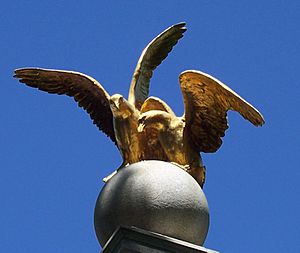
In 1912, Young suggested the Seagull Monument to the LDS Church again. This time, they offered him a contract and money for his living expenses. His son, Mahonri "Bill" Sharp Young, was born in New York in 1911.
After the Seagull contract, Young worked on art for a Hopi Indian exhibition. He visited Arizona, New Mexico, and Utah for ideas. He also created dioramas for Navajo and Apache tribes. The Seagull Monument was officially shown on Temple Square on October 1, 1913.
Young became friends with artists from the Ashcan School. He helped organize the 1913 Armory show. This show introduced new art styles like Cubism. Young did not like abstract art. He felt these new styles were a "threat."
In 1915, Young joined The Brooklyn Society of Etchers. This group worked to promote American etchings. His etchings were shown at their first exhibition in 1916. He also won a silver medal at the Panama–Pacific International Exposition in 1915. His Apache sculptures were shown in 1916.
Cecelia Sharp, his first wife, died in 1917. Young later returned to Paris to study art from 1925 to 1927. In 1923, he was elected to the National Academy of Design. His Navajo statues were shown in New York in 1924.
In 1926, Young submitted a sculpture for a pioneer woman monument but lost the competition. He called this his biggest disappointment. In 1928, his boxing sculptures were shown in New York. He also created a bronze sculpture of boxer Joe Gans in 1929.
Young married Dorothy Weir on February 17, 1931. She was the daughter of a painter. They moved to the Weir family farm in Connecticut. Young had an art studio there, which is now the Weir Farm National Historic Site.
In 1932, Young entered eight boxing statues in the Art competitions at the 1932 Summer Olympics. His sculpture The Knockdown won the gold medal for sculpture. He began teaching at the Art Students League in 1934. In 1941, Life magazine called him "the George Bellows of American sculpture."
His large sculptures, "Industry" and "Agriculture," were shown at the 1939 New York World's Fair. They stood at the fair's entrance.
This is the Place Monument
Mahonri Young had a special connection with the LDS Church. Even though he wasn't very active in the church, he admired its leaders. He was proud of his pioneer family history. He worked hard to get projects for the church.
His most important artwork is often thought to be This Is The Place Monument. It is located at This Is the Place Heritage Park in Salt Lake City. This monument celebrates the 100th anniversary of Brigham Young and the pioneers arriving in the Salt Lake Valley in 1847.
Young did a lot of research and sketching for the project. He was sure he would get the job. After trying for five months, he was frustrated. He even tried to get U.S. senators from Utah to help get federal money for the project.
The committee decided to make the monument a competition. Young was worried because he had lost a previous competition. John Fairbanks, a younger artist, was his main competitor. In 1939, LDS President Heber J. Grant chose Young's design. It showed important figures like Brigham Young, Heber C. Kimball, and Wilford Woodruff.
Young was given $50,000 to build the monument in 1939. He was 62 years old. After he got the contract, some of his artistic ideas were changed by government and church leaders. For example, Young wanted the pioneer leaders to wear realistic clothing. But they were shown in formal overcoats instead.
Young worked on the statues with help from Spero Anargyros. The monument was dedicated on July 24, 1947. This was the one-hundredth anniversary of Brigham Young's group reaching the Great Salt Lake Valley. It is the largest sculpted monument in Utah.
In 1947, Young became a member of the American Academy of Arts and Letters. Dorothy Weir, his second wife, died in May 1947.
His last major work was a six-foot statue of Brigham Young for the Statuary Hall in the United States Capitol Building. It was shown in Washington D.C. in 1950. He carved this work in Italy.
In 1955, Young took part in an art exhibition in New York City. In 1957, he had a serious stroke. Mahonri Young died in Norwalk, Connecticut on November 2, 1957, at eighty years old. He was buried in the Salt Lake City Cemetery.
Art Style and Works
Mahonri Young learned traditional art styles in France. But he was more interested in showing the real life around him. His work is often linked to social realism. He showed workers, immigrants, and people's connection to nature.
Young's art showed many different things. He was skilled in etching, drawing, watercolor, oil painting, and sculpture. He always carried a sketchbook. He would use pens, ink, oil, and watercolors to draw scenes he saw on farms.
Some art critics compared Young's work to famous artists like Jean-François Millet and Honoré Daumier. Young's early sculptures were also influenced by Auguste Rodin. Young's sculpture of fighting boxers, Right to the Jaw, shows Rodin's style with its curves and movement.
Young's experience as a sketch artist gave him a quick, spontaneous style. He was excellent at showing "figures in motion" and the small details of how people move. Instead of focusing on light and perfect looks, Young focused on rhythm, balance, movement, and design in his art.
Legacy and Impact
Mahonri Young's career lasted over fifty years. His artworks have been shown in more than fifty museums and galleries in the United States and Europe. When he died, he left behind hundreds of sculptures, paintings, and thousands of drawings.
Young was the first artist from Utah to have his work displayed in the Metropolitan Museum of Art in New York. He also received almost every art award offered in Utah. The Springville Museum of Art called him "Utah's most famous New York-based artist."
According to the Encyclopedia of Mormonism, Young became well-known across the country for his sculptures and graphic art. An art critic named Guy Pène du Bois said that Mahonri Young was a rare and great sculptor in America.
In 1999, the Brigham Young University Museum of Art held a year-long exhibition of his work called "Mahonri: A Song of Joys." The Young family gave over 7,000 of his artworks to Brigham Young University. The BYU Museum of Art also had another exhibition of his work in 2019.
Images for kids
-
Seagull Monument, 1913. Temple Square, Salt Lake City, Utah
See also
 In Spanish: Mahonri Young para niños
In Spanish: Mahonri Young para niños


